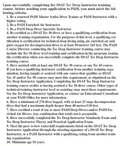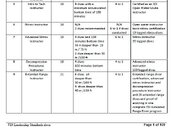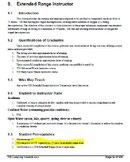DevonDiver,
There is a lot of anti-PADI opinion in the world and it is rampant on Scubaboard. Providing these people with the facts will not change their opinion.
I was recently in Europe and wanted to join a CMAS club on a weekend diving trip to a local lake. They refused to allow me to join because I was PADI and SSI. They said that I could have joined them if I was only SSI.
I do not have a lot of experience with different diving agencies, just SSI and PADI. In my personal opinion PADI is better than SSI. But that is not the say that all PADI instructors are better than all SSI instructors or that the course material is better. It is just that I received better training from PADI than I have from SSI. If I would have listened to the anti-PADI propaganda floating around I would have missed on some very through training and be a poorer diver as a result.
Technical diving is technical diving. Even accounting for varied agency (or personal) philosophies, the same basic skill-set and scope of competencies exists across the board. An instructor can either prepare people to undertake such dives safely and competently, or he/she cannot.
I've looked long and hard at varied agencies in the recent years. I've been privileged to train in several already.. and have been considering additional agencies in which to progress instructor status. To be honest, none of them are 'perfect' in my opinion. All have strengths and weaknesses.. all have good and bad instructors.
PADI (TecRec) makes sense for me. I actually think their entry-level tech syllabus (Tec40-50) is well thought out. They don't like to involve themselves in overhead environment, it seems, which doesn't quite suit me as I like to specialize in wreck diving. PADI have an enormous marketing machine though - and TecRec courses still develop the most inquiries I receive. On the down side, PADI have been keen to expand their tech market share - that means saturating the market with instructors (as they do with rec diving). To achieve this, they lowered standards, made the process quicker... gave people instructor certifications they aren't expert to teach.
I had the option to cross-over at technical level to SSI. I was already an SSI recreational instructor. The TXr program is ok... but hasn't benefited from any marketing or awareness raising. SSI also require a formal shop-instructor relationship - that doesn't suit me as an independent instructor. There seemed no benefit to me for investing to get SSI TXr instructor tickets.
BSAC have no real foothold here in the Philippines, so there was little point in chasing tech-level instructor qualifications with them (I qualified as a BSAC instructor first). I also don't like their disapproval of the hogarthian long-hose configuration. Of all the agencies I am very familiar with, BSAC seem the least 'in-touch' with technical diving progress.
ANDI was a natural choice for me - I have access to an extremely experienced mentor, who is a personal friend. ANDI seem to have high-standards for instructor entry and the conduct of diving. I was impressed with their wreck and technical wreck courses. I also like their sidemount/advanced sidemount courses; which are more focused upon overhead environment applications (right up my street). I've been progressing my ANDI tech-level instructor ratings for the past few years and it's been a good challenge. They are one of the oldest tech agencies...and have good pedigree. I also like that ANDI make specific effort to support the instructor/shop as an agency priority. The only drawback I see with ANDI is that they haven't yet managed to decipher the 'riddle' of internet and social-media marketing. The agency doesn't attract much interest - only the reputation of individual tech instructors seems to ensure inquiries come in.
I have thought long and hard about IANTD. They have a good reputation. They aren't so well represented here in the Philippines (they are here though) and, just my personal opinion, seem to have been losing market visibility over recent years. If I was still in the UK, I might well have investigated instructor membership more closely.
TDI must vary around the globe, I think. I did my first technical training with TDI (Mark Powell, in the UK) and it was excellent. TDI are a very well known tech agency now. In the Asia region however, I did hear complaints that they had done a 'market share grab' in recent years - massively increasing the instructor population through fast-tracks and low-commitment cross-overs...at the expense of diluting instructor quality. They do have a very broad range of courses however, and seem interested in proving new areas of instruction. I might well consider TDI cross-over in the next 1-2 years.
GUE and UTD are just to rigid for my liking. I like to teach my students to think, to assess, to investigate and to decide. Strict philosophies degrade that freedom of expression. GUE doesn't do sidemount...and their CCR is very limited. UTD have been expanding a lot with instructor cross-overs etc... I've seen some iffy instructors grab up UTD ratings, which raises question marks. Plus, the Z-manifold is such a turn-off. I am a "99%" DIR diver... but sorry, I took the red pill (not the kool aid) and I'm happy to see how deep the rabbit hole goes..
PSAI and NAUI... sorry, nobody ever heard of them where I live...









